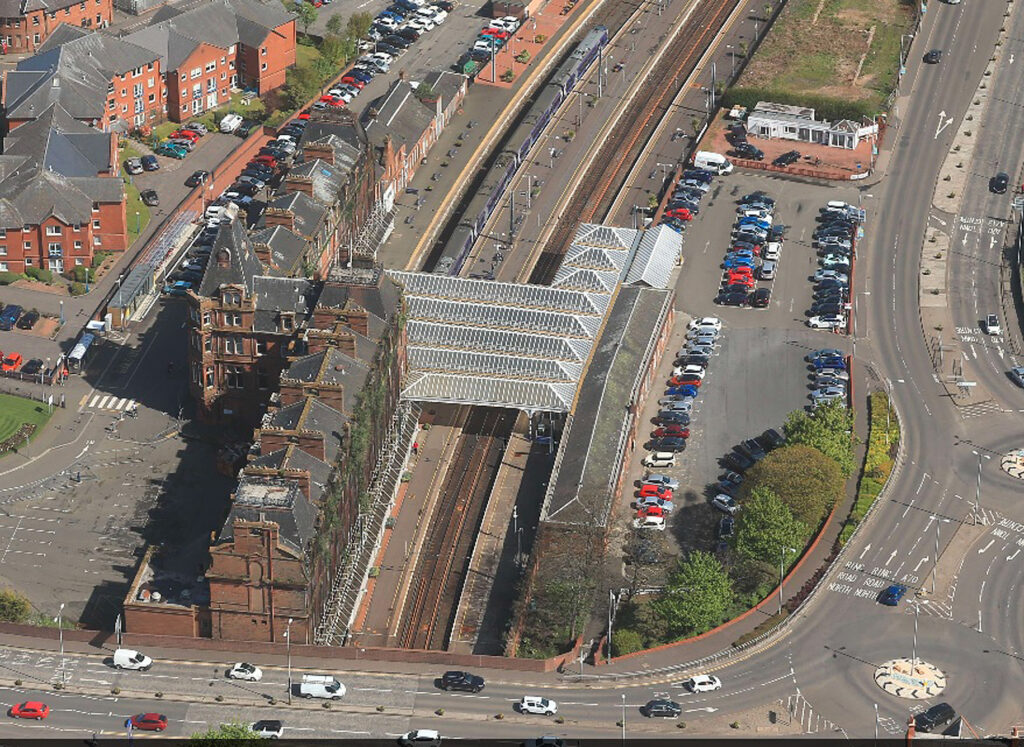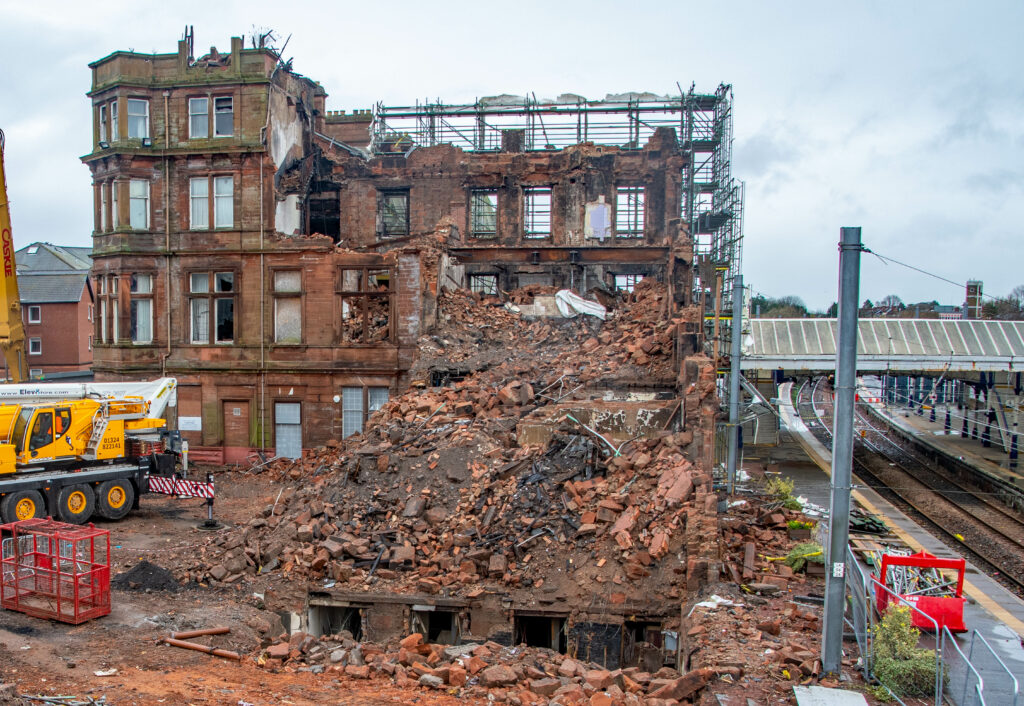The impressive grade-B listed Ayr Station Hotel was built in 1885 in the French-Renaissance château-style and was an integral part of the station with the travel centre inside the hotel’s north wing. In 2010, it was purchased by a Malaysian businessman who abandoned it after it closed in 2012. With the hotel not being maintained, the following year South Ayrshire Council issued a Dangerous Building Notice (DBN). In response, Network Rail erected crash decks over the station entrance and to protect platforms by the hotel.
The 2018 DBN

The building continued to deteriorate as the council unsuccessfully attempted to contact the hotel’s owner. As Rail Engineer reported in December 2018 (issue 170), in August that year, the council issued a further DBN and declared an exclusion zone around the hotel. Services from Glasgow were then short-formed and those between Stranraer and Ayr were suspended. After the hotel had been encapsulated and other work done, trains to Stranraer resumed in November and the normal train service to Glasgow resumed in December. This exclusion zone also closed the travel centre which was replaced by an outside ticket office in a portacabin.
Since then, the Council unsuccessfully continued to attempt to contact the absent owner and seek recompense from him through the British and Malaysian courts. In 2021, Transport Scotland commissioned a study to identify options for an economically viable future for the Station Hotel building. There were also strong representations from groups who wished to see the hotel restored to its former glory.
Nevertheless, due to its unsafe condition, in December 2022 the council decided that the hotel’s south wing had to be demolished. At its September 2023 meeting, the council was advised that surveys were being undertaken so that a detailed programme of works for this demolition could be finalised. It was expected that this programme would be completed in February 2024.
Yet, in the five years since the 2018 DBN notice, the situation at Ayr station remained unchanged whilst £69,000 per month, totalling around £4 million over this time, was spent on scaffolding costs.
Hotel fire
Matters changed dramatically on 25 September 2023 when an arson attack started a serious fire which left the building in a hazardous state. Train services were immediately suspended and the road by the hotel was closed. Trains from Glasgow were terminated at Prestwick and a reduced service ran between Girvan and Stranraer until the diesel units required maintenance and were unable to return through Ayr station to their depot.
The resultant exclusion zone was larger than the one declared in 2018 when it was still possible to run four-car electric trains from Glasgow to the station. After the 2023 fire the station was completely shut for 10 weeks until it was possible to introduce a shuttle two-car diesel unit service between Prestwick and Ayr in December. Glasgow to Ayr trains are normally seven-car electric multiple units.

A contractor started work to make the hotel safe in October. By December, the south wing had been demolished to the extent necessary to open the adjacent road. In January, the council advised that this work would continue until in mid-March when it was expected that train services would be able to resume. However, on 5 March it was announced that a severely damaged wooden supporting beam in the north wing had been discovered.
Once sufficient demolition work has been done to enable the exclusion zone to be lifted, Network Rail’s engineers will have to inspect the unused lines to confirm their safety. ScotRail have also warned that drivers will require route retraining which would further delay for the resumption of services. As a result, according to the National Rail website, disruption to rail services is now expected to continue until 2 June.
It is now over 10 years since South Ayrshire Council issued its first DBN. During that time the station has become increasingly unsightly, passengers have had to buy their tickets in the open, and the train service has been seriously disrupted. In 2017/18, 1.67 million passengers used Ayr station. The following year, this number was reduced by 200,000 after the disruption from the 2018 DBN. The disruption following the September fire will also have significantly reduced passenger numbers.
Ayr is a seaside town that attracts many visitors who could well be put off visiting the town for its lack of an attractive rail service. There are also concerns of a significant reduction in numbers coming to the town for the Scottish Grand National in mid-April, and a two-day music festival in early May. It would seem clear that the condition of Ayr Station Hotel has had a significant adverse effect on the town’s economy.
The law
Yet what could the cash-strapped council have done with this Grade B listed hotel when faced with an unresponsive overseas owner? The council has exercised its powers under section 29 of the Building (Scotland) Act 2003 which gives local authorities an obligation to carry out whatever work is necessary to protect people and property adjacent to a dangerous building, and recover associated costs from the owner.
However, if, as in this case, the dangerous building is listed, the council can’t legally remove any more of the structure than is absolutely necessary. Yet section 21 of the 1997 Planning (Listed Buildings and Conservation Areas) (Scotland) Act allows planning authorities to revoke listed building consents as they consider expedient. The council appears not to have considered this option.
Network Rail could also have applied to the Cabinet Secretary for Transport for consent to invoke section 15 of the 1842 Railway Regulation Act to compulsorily acquire the hotel and deal with it. However, this would make Network Rail entirely liable for the hotel.

The future station
In January, South Ayrshire Council launched a consultation exercise on its Ayr Town Centre Framework plan which includes five specific projects to improve the town centre, one of which is a new station and transport interchange. This is one of the options from the Transport Scotland study on the future of the hotel and station. The proposed station offers easier access from the town centre by a new footbridge over the site of the now-demolished south wing of the hotel. To create a new transport interchange the town’s bus station is to be moved adjacent to the station. It is envisaged that this new interchange will open in 2028.
The graphic of the new interchange shows that, except for the south wing, the hotel buildings will be retained. However, with the recent announcement on the condition of the north wing, it seems quite possible that this will also be demolished.
The new station will certainly be a huge improvement. Yet in the meantime it seems Ayr’s normal train service will not resume until at least eight months after the hotel fire. Having an adjacent dangerous building shut the railway for eight months is surely unprecedented and it is difficult to imagine that this situation would have been tolerated had it occurred next to a major rail route.
No doubt there are lessons from the sad saga of Ayr’s Station Hotel. Any such lessons need to be shared throughout the rail network to avoid a lengthy suspension of rail services should a similar situation occur elsewhere.
Lead image credit: David Shirres

